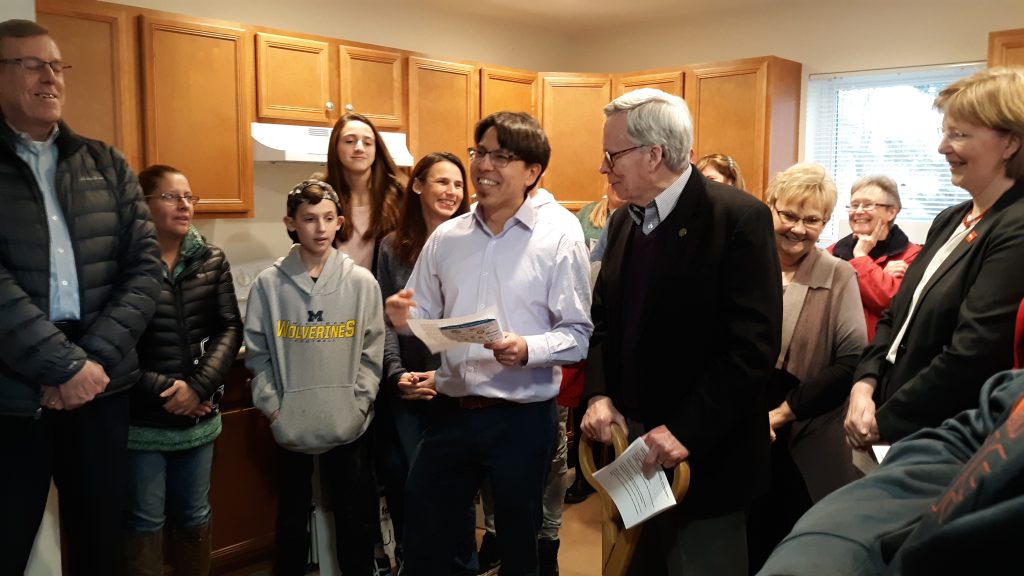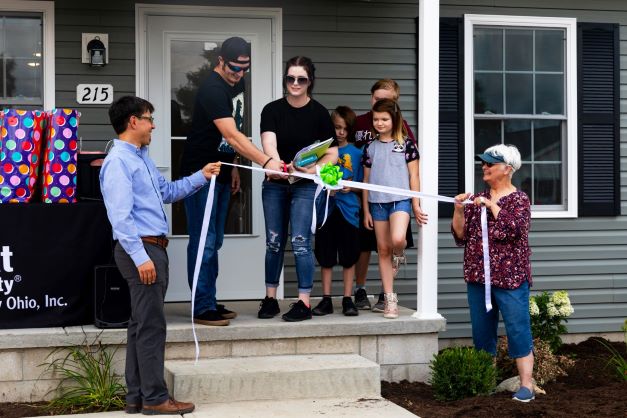By JAN LARSON McLAUGHLIN
BG Independent News
The Barnett family lived in a 30-year-old manufactured home in Bowling Green with water leaks, electrical problems, rotted floor boards, a leaning foundation, and vents that possums entered through twice.
Jon and Ally Barnett dreamed of a decent home with room for their growing family. Their fourth child was on the way, and their eldest child was already sleeping on the couch.
The neighborhood, with frequent calls for police responses, was far from ideal for raising a family.
On a whim, the couple applied for a home through Habitat for Humanity of Wood County. But their expectations were low.
“We always got turned down by lenders,” Jon Barnett said.
And the Habitat application process was thorough, Barnett added.
“I’m not gonna lie, there was a lot of paperwork to get done.”
But the family qualified for a Habitat home, and was selected for the next home being built in Wayne, east of Bowling Green.
The Barnetts and their four children moved into their new home this past summer.
“We were happy we were no longer in a home that was falling apart,” Jon Barnett said to a crowd gathered Friday evening for a Habitat for Humanity fundraiser. “This is home. It is where we plan to grow old together.”
“Our family is so incredibly grateful,” Ally Barnett said as she looked out at volunteers who helped build their home, at business owners who donated building goods, and at donors gathered to help with future homes being constructed in Wood County.
In the past 30 years, the local Habitat organization has built 52 homes in communities throughout the county. The 53th home is under construction in Grand Rapids, and after that another is planned in Northwood, then another in Wayne.

Like many families, the Barnetts were caught in a common dilemma, said Mark Ohashi, executive director of Habitat for Humanity of Wood County. Many must decide between affordable and decent housing.
“What is affordable is not decent,” and what is decent is not affordable, he said. “Families are forced to make due with inadequate housing because it’s affordable.”
The goal of Habitat is to provide both.
That was the aim when the first Wood County house by Habitat was built in Bloomdale in 1993. Gary and Judy Kellermeier, of Bowling Green, saw the need as they worked with a task force examining homelessness in Wood County.
On Friday evening, Gary Kellermeier talked about being the site manager at the very first home built by Habitat volunteers. And he spoke of managing construction of the local homes for the first seven years in the county.
Ohashi said the average rent for a three-bedroom home in Bowling Green is $1,200. For many families, that rent would devour close to half of their monthly earnings.
“Decent affordable housing is out of reach for many families,” he said.

A Habitat home can not only provide safe housing, but also allow families to focus on other progress. It could allow for more schooling, which could lead to a promotion and pay increase.
“Securing a Habitat home for a family is not the end of the journey. It’s the beginning,” Ohashi said. “Our families are hard-working families who are not seeking a handout, but a hand up.”
“I thank you for making decent and affordable housing possible,” Ohashi told the crowd at the fundraiser.
Also at the event, an announcement about a new Habitat ReStore in Wood County was made by Sue Clark, a member of the committee working on finding a site and funding for a ReStore.
Clark described a Habitat ReStore as a mix between Goodwill and Home Depot, selling furniture, appliances and building supplies at low rates. The revenue from the store would help Habitat repair and build more homes in the county, she said.
The average Habitat home costs about $150,000 in building materials. The organization benefits from corporate sponsors, reduced costs from vendors and occasional government grants. But those are dependent on the economy.
“When the economy goes south and purse strings are tightened,” Habitat is vulnerable, Clark said. A ReStore could provide some steady funding when times are tough.
“It is about becoming self-sufficient,” she said.
It is hoped a ReStore can be opened in the county within a year, Clark said.


